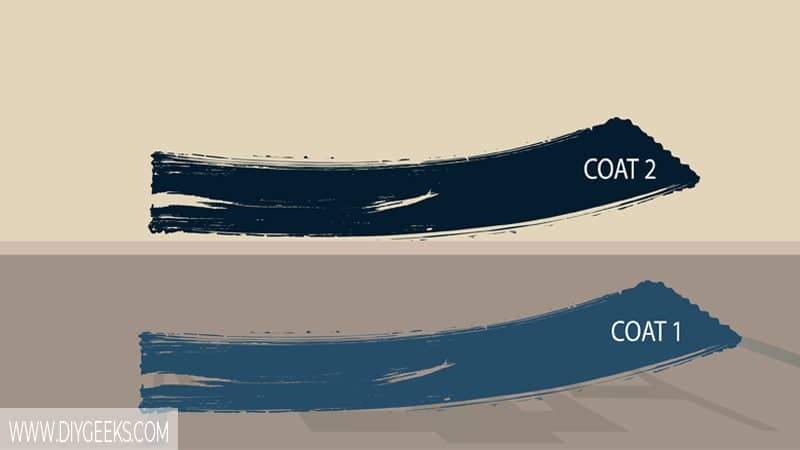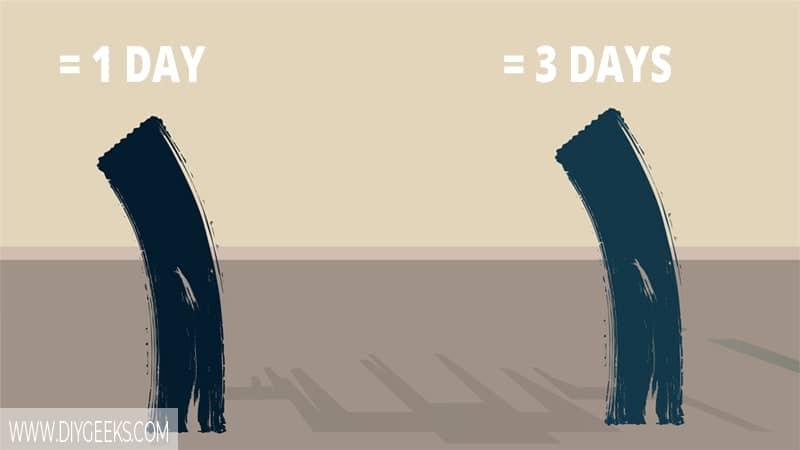The paint does get darker as it dries. The change in color shade is because when the paint is wet, the solvent and other additives make it look lighter, but once the solvent evaporates, the color shade becomes darker.
Whether a second paint coating makes the color shade appear darker or lighter depends on the paint type, color, and existing color shade.
Water-based paints tend to get darker with a second coating, while oil-based paints don’t change their color shade as much.
Does a Second Paint Coat Make the Finish Darker?

Whether a second paint coating makes the finish darker depends on the paint type, color, and base color. A second paint coat makes some paint types darker while it doesn’t affect some other paint types.
For instance, a second paint coat makes latex paint darker but doesn’t make oil-based paints darker. Darker color shades show a bigger difference with a second coat, while white (or bright) color shades don’t show a noticeable difference.
If you are painting over a painted surface, the existing color shade can determine the finish color shade. If you apply a dark color shade over a white finish, it may take more coats to achieve the desired color shade.
A second coat can make the finish appear darker if the paint is still wet. When the paint is wet, it appears darker due to solvent presence, but once the solvent evaporates the finish color shade will be the same as the first coating.
What About The Third or Forth Coat?
Additional paint coats can affect the paint finish color shade. The more paint coats you add, the more paint pigments on the surface that create a uniform color shade.
Multiple paint coats make the color shade appear darker (or lighter) because they cover the surface imperfections and existing color shade, and form a uniform and consistent color shade that appears darker.
Applying more coats won’t make the finish appear darker once the new paint finish forms a uniform and consistent color shade, and the surface imperfections and the existing color shade are covered.
Does Paint Get Lighter or Darker When It Dries?

The paint gets darker after it dries. The color shade change is because when the paint is wet, the solvent and other additives make the color shade lighter, but once the solvent and additives evaporate, the color shade becomes darker.
However, the surface type and room lighting can make the paint finish color shade appear different.
For instance, the paint finish color shade appears darker if you paint over a dark wood, but the same paint will appear lighter if you paint over a white wood. To prevent this apply more coats to achieve a consistent and uniform paint finish.
If you paint in a room with many lights, the finish will appear brighter when dry. The finish will appear darker if you apply it in a room with less lighting.
Does a Sealer Change the Paint Color Shade?
A sealer does change the paint color shade. While most sealers are transparent (colorless), they have a glossy top layer that makes the finish appear lighter (or darker) if exposed to light.
For instance, a wax sealer makes paint finishes appear darker, while a polyurethane sealer makes finishes appear lighter.
However, the change in color shade is because of the sealer’s glossy top coat. If you remove the sealer top coat, the underlying paint will have the same color shade as before sealing.
Tips To Avoid a Different Paint Color Shade
Tips to avoid a different paint color shade are listed below.
- Sand and Prime: You must sand and prime porous surfaces, such as wood, before painting them. If you don’t, porous surfaces will absorb too much paint and create a lighter color shade since there’s less paint over the surface.
- Allow Enough Dry Time: Wait until one coat dries before applying the next one. If you re-coat too soon, the solvent gets trapped between two coats and can make the paint remain wet for longer, causing the finish to look deeper.
- Use a Transparent Sealer: Most paint sealers change the color shade a bit, but transparent sealers don’t change it as much. Avoid tinted paint sealers are they will cover the existing color shade.


